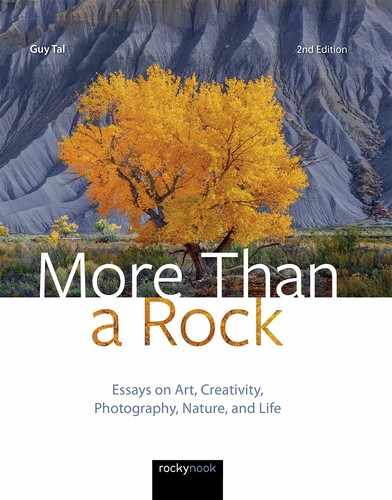29Of and About
A thing is not what you say it is or what you photograph it to be or what you paint it to be or what you sculpt it to be. Words, photographs, paintings, and sculptures are symbols of what you see, think, and feel things to be, but they are not the things themselves.
—Wynn Bullock
Shortly before his death, and after an illustrious career, Minor White was asked what he thought of the work being done by budding photographers, and whether there were any trends he found interesting or was critical of. His response was this: “There’s no particular class of photograph that I think is any better than any other class. I’m always and forever looking for the image that has spirit! I don’t give a damn how it got made.” As I read this, it seemed obvious and intuitive to me to recall those images I had seen that felt to me like they had “spirit,” and yet, I found it challenging to articulate in words what the term meant to me. It was one of those “I know it when I see it” concepts.
Looking past considerations of aesthetics, subject matter, technology, and other qualities of photographic images already addressed by well-defined terminology, I tried to distill what remains that may qualify as “spirit.” I realized that I find more value in images that express subjective notions rather than images that are merely objective representations of fortuitous subjects and circumstances. In more general terms, I tend to prefer images that are primarily about things to images that are primarily of things. To me, those images that “have spirit” are images about, and not images of.
In another essay in this book I refer to the elusive quality of “aboutness” as the thing I seek to express in my work. Paul Strand used the term “meaningness,” and other artists often spoke of “significance.” They are, I believe, all referring to that same intangible quality White called “spirit.”
Robert Capa’s image The Falling Soldier is to me an image about the horrors of war rather than an image of a dying man. Paul Strand’s Wall Street image is about human beings made small and insignificant by the imposing facade of a large corporation, rather than simply an image of pedestrians on a sidewalk. Dorothea Lange’s Migrant Mother is an image about the human toll of the Great Depression, not just an image of Florence Owens Thompson and her shy children.
What an image is about—its significance, meaning, and story—does not come from any subject, tool, or technique; it originates from the mind of the person behind the camera. When such an image represents the singular sensibilities of a unique individual rather than just the aesthetic qualities of some objects, the work is elevated in the sense that it could not have been made by anyone else. It is, in a larger sense, part of that person’s contribution to the world, to art, and to other artists. Other than serving its immediate purpose, such an image also becomes part of a photographer’s artistic legacy—a tribute to, and a reason to commemorate, the photographer’s life.

